This handout specifically addresses Primary Sources in Science. For information about locating Scholarly and Peer-Reviewed journals in general, see Identifying Scholarly Journals.
In the sciences, primary literature reports on research conducted by the authors.
When you see an article in a scientific journal, there are several clues that it is primary literature. The most important clues are 1, 2, 4, and 5 below.
1. The authors are identified.

2. The authors' affiliations are identified. These are usually universities or scientific institutions.

3. Sometimes the abstract shows evidence that the article is about the author's own research:

4. The authors explain how they did their research. Look for a "Methods," "Materials and Methods," or "Experimental" heading within the article. In shorter articles, often called brief reports, short communications, or letters, there won't be any internal headings but if you read carefully, you will find a brief explanation of how the authors did their research.

5. The authors report their findings. Look for a "Results" heading within the article." In shorter articles, often identified as brief reports, short communications, or letters, there won't be any internal headings, but if you read the article you will find that the authors report their findings.

6. The authors identify the references they used as background for their research. Science advances by building on previous research, and it's important to acknowledge the work that has gone on before. Note that secondary literature, such as review articles also have references. (For more on review articles, see What's Not a Primary Research Article below.) However, the absence of any references is a strong clue that you are not looking at a primary article.

7. Primary articles often contain graphs and tables. However, secondary literature, such as review articles may also have graphs and tables.
Primary articles are often peer reviewed (sometimes called "refereed"). However, secondary literature, such as review articles may also be peer reviewed.
Peer review means that the article was read and critiqued by other experts on the topic at the request of the editor of the journal. Often the peer reviewers will ask for clarifications or changes to the article. Once the authors have completed their revisions, the article is accepted.You can often determine that an article is peer reviewed by looking at the article for the date received and the date accepted or date published. The article was peer reviewed in the interval between those dates.










Identifying primary research and peer review articles gets easier with practice. If you have questions about an article, just ask.